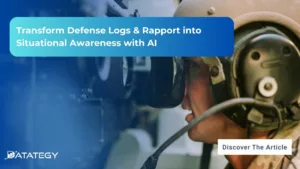Transform Defense Logs & Rapport into Situational Awareness with AI...
Read MoreCDO: what criteria to choose for your AI platform?
Table of Contents
Toggle
Table of Contents
Toggle
According to an article in Forbes, 80% of companies are now investing in artificial intelligence. Many organizations have launched POCs (Proof of Concept) in recent years, supporting this desire to go further. Some large companies have already set up real “data intelligence” centers.
CDOs and data teams are beginning to define the contours of the AI environment most likely to bring projects to fruition. So what criteria should be taken into account when choosing an artificial intelligence platform? Answer in this post.
Criteria #1 - An all-in-one platform
For more efficiency, it is important that the chosen AI solution offers a unified working environment where all the tasks of a data project can be performed:
Data collection: having a platform where data is accessible is essential to share it within the company, remove duplicates and improve its quality and reliability.
Data visualization: this is the possibility of creating customized visualizations from different models (histograms, maps, pie charts, curves, point clouds, etc.) in 2D or 3D. Before predictive analysis, this is used to explore the available data, judge their relevance and quality.
Data cleaning: beyond visualisation, it is important to facilitate data preparation, to automatically recognise duplicates, inconsistencies or missing values, to make the subsequent analysis more reliable.
Navigating the data: one of the key success factors of AI is the access to all available data. The AI solution must connect to existing data sources, map them to enable users to search for useful information easily, access it quickly and store it in a single location, without unnecessary duplication so to avoid deteriorating the ecological footprint The platform must thus allow the different business lines to access data, to collaborate and to have a single AI repository.
Criteria #2 - The variety and number of algorithms
An AI solution is expected to be able to process large volumes of data and to adapt to a wide variety of data projects, some of which are complex. The possibility of using a wide range of AI algorithms will determine the analytical potential of the solution. A platform that makes a wide range of algorithms available and that is enriched as the technology advances is a real plus for the organisation.
This makes it possible to manage complex projects and to provide data scientists with proven algorithms to save time. Depending on their structure, nature and topology, some data will not reveal anything exploitable with a given algorithm, whereas it will be full of lessons with a different one. This functional richness makes it possible to gain in reactivity and to increase the added value for the business.
Criteria #3 - Scalability
The volume of data will be increasingly important and new algorithms will emerge and be refined. An AI platform is chosen for today as well as for tomorrow. It must therefore be “scalable”, i.e. able to adapt to the growth of future projects. An AI platform will only be sustainable if it can, through its structure, accommodate new algorithms, and through its data processing and formatting capacities.
Criteria #4 - Cost and ROI
Artificial intelligence projects are known to be expensive and difficult to make profitable. The level of investment in the solution is therefore of significant importance. An AI tool that is able to reuse existing models and algorithms, improve collaboration between data scientists and different business lines will offer a better return.
In addition, some platforms also allow for quick testing of models to see if they work, before deployment.
Criteria #5 - Transparency
In predictive analysis using AI, it is essential to have a record of the different steps that led to the result and to be able to go back if necessary. This transparency, along with a summary of the actions taken, is essential for users to know at any time what information or action led to the result, what factors influence the analysis and therefore the predictions proposed.
Having a platform that provides this readability is key to pinpointing useful data, adjusting predictions and providing a better understanding of the results. Companies are looking for transparency and understanding to clarify the contribution of the different algorithms. The goal is to help people make decisions, not supplant them with algorithms.
Criterion #6 - Ease of Use
For easier adoption and optimal use, it is in the company’s interest to favour an AI platform operating in no-code or low-code. Thus, employees with an appetite for data can manage their projects via a modelling studio, and carry out their AI processes using existing algorithms without having to do advanced programming or call on a data scientist.
This is a real plus for quickly developing business projects, analysing a business intuition and validating the value that can be gained from it. Stakeholders can be involved at every key stage of the process and have a critical eye on the results.
Having a platform that provides this readability is key to pinpointing useful data, adjusting predictions and providing a better understanding of the results. Companies are looking for transparency and understanding to clarify the contribution of the different algorithms. The goal is to help people make decisions, not supplant them with algorithms.
Criteria #7 - Integration and Maintenance
The choice of solution also depends on how easily it can be integrated into the company’s IS. The ideal AI platform allows for easy integration with different applications, synchronization with databases and the company’s BI environment.
The choice of a “cloud agnostic” solution guarantees independence for the deployment of the platform, which can be done at the hosting company chosen by the company, in accordance with its data localisation and sovereignty policy.
The ease of upgrading and scalability of the AI platform are also key. This is especially important as algorithmic models are continuously being improved. It would be a shame not to take advantage of this. Finally, the support of the editor and the contribution of his AI expertise must be taken into account when choosing a platform.
There are other criteria to take into account. However, those described in this article seem essential to facilitate the success of AI projects and the internal collaboration they require.
Learn more about our platform
Recommended articles
Why AIOps Is Key to Cyber Threat Detection in Defense?
Why AIOps Is Key to Cyber Threat Detection in Defense?...
Read MoreHow AI Transforms Predictive Maintenance in Defense Equipment
How AI Transforms Predictive Maintenance in Defense Equipment In a...
Read More

